You'll get the most benefit from red light therapy by keeping sessions to 10 minutes per muscle group. This timing allows ideal cellular regeneration as your mitochondria produce ATP and antioxidants while avoiding diminishing returns from longer exposure. Your muscles need this sweet spot to trigger protein synthesis and repair mechanisms without overwhelming the tissue. The 10-minute window maximizes blood flow and reduces inflammation while preventing excess muscle fatigue that could impair recovery. Following this timing guideline gives you the perfect balance of stimulation and regeneration – but there's more to achieving peak recovery results.
Science Behind Red Light Therapy

While athletes have long sought effective recovery methods, red light therapy has emerged as a scientifically-proven technique for enhancing muscle repair and regeneration. When you expose your muscles to red light, it triggers a cascade of cellular responses that enhance your recovery process.
The science centers on your mitochondria, the powerhouses of your cells. Red light penetrates your tissue and stimulates these cellular engines to produce more ATP, your body's primary energy source. Studies show that red and near-infrared light effectively penetrates deep into joints and tissues.
You'll experience enhanced blood flow as the light energy interacts with your skin and muscles, delivering essential oxygen to cells that need it most. This increased circulation, combined with reduced oxidative stress, creates a favorable environment for healing.
What makes red light therapy particularly effective is its ability to simultaneously address multiple aspects of recovery. You'll benefit from reduced inflammation, which directly impacts muscle soreness, while the therapy stimulates cell regeneration for faster healing.
Clinical research consistently shows that red light therapy outperforms traditional recovery methods like cryotherapy, especially when it comes to reducing delayed onset muscle soreness and improving strength gains.
Optimal Exposure Time Per Muscle
You'll get the best muscle recovery results by positioning the red light 6-12 inches from each targeted area for 2-10 minutes, depending on the depth of the tissue.
For optimal healing outcomes, near infrared light is most effective for reaching deeper muscle tissue and bones.
To avoid muscle fatigue while maintaining effectiveness, it's smart to break up your sessions into quick sets of 2-3 minutes per muscle group if you're treating multiple areas.
Your total session shouldn't exceed 120 joules of exposure, so you might need to alternate between muscle groups across different days when working on full-body recovery.
Time-Under-Tension Sweet Spot
The science of time under tension reveals distinct sweet spots for different training goals. When you're focused on muscle growth (hypertrophy), you'll want to aim for 40-60 seconds of tension per set, while strength gains require just 4-20 seconds. This means you'll need to adjust your rep pace accordingly, rather than simply counting repetitions.
To maximize your muscle growth within the 10-minute exposure window, you should perform each rep deliberately, taking 5-10 seconds per repetition. This slower pace guarantees you're hitting the ideal time under tension for hypertrophy. Training with slower tempos helps protect your joints and ligaments from potential injury.
While faster reps might let you complete more sets, they won't provide the same growth stimulus as controlled, time-focused movements.
You'll achieve the best results by structuring your training around 2-3 sessions per muscle group weekly, accumulating 10-20 sets in total. Within your 10-minute window, focus on maintaining proper form while keeping each set within that critical 40-60 second range.
Muscle Fatigue Vs Duration
Finding your ideal exposure time means balancing muscle fatigue against training duration for each session. When you're training each muscle group, the sweet spot often lies around 10 minutes per session, as this allows you to maintain intensity while preventing excessive fatigue. During this time window, metabolic products accumulate gradually without overwhelming your muscles' ability to function effectively.
Research shows that muscle growth benefits typically peak within 24-48 hours after training, making it essential to fine-tune your exposure time.
You'll need to take into account that longer workouts don't necessarily yield better results. Instead, focus on the quality of your training time rather than quantity. While your muscles can handle various repetition speeds, maintaining proper form becomes increasingly difficult as fatigue sets in, especially beyond the 10-minute mark per muscle group.
- Train each muscle group 2-3 times weekly, spacing sessions 24-72 hours apart for ideal recovery
- Keep your per-muscle training time to around 10 minutes to maintain high-quality performance throughout the session
- Adjust your exposure time based on your fitness level, ensuring you can complete 10-20 total sets per muscle group per week
This approach helps you maximize your training efficiency while managing fatigue and supporting proper recovery between sessions.
Quick Sets Done Right
Mastering quick sets requires a strategic balance of rest periods and rep ranges to enhance muscle growth. You'll maximize your results by focusing on moderate rep ranges (10-20 reps) while incorporating intra-set rest breaks. This approach allows you to maintain higher power output without sacrificing the anabolic stimulus. Circuit training and HIIT can be effectively integrated into your strength routine for enhanced fitness benefits.
| Strategy | Benefit |
|---|---|
| 60s Intra-Set Breaks | Better strength gains than 120s between sets |
| Drop Sets | 10% muscle growth vs 5% with regular sets |
| 20-Rep Sets | 10% size increase vs 5% with 8-rep sets |
To structure your quick sets effectively, start with heavier weights and progress to lighter loads within your session. This sequencing prevents micro-tearing and reduces injury risk. You don't need perfect recovery between sets – aim for about 90% recovery to maintain efficiency. When planning your workout, remember that smaller muscle groups like biceps and triceps can handle higher training frequencies, while larger muscle groups need more recovery time. By combining these strategies with appropriate rest periods, you'll achieve ideal muscle stimulation within your 10-minute per muscle target.
Cellular Regeneration During Recovery
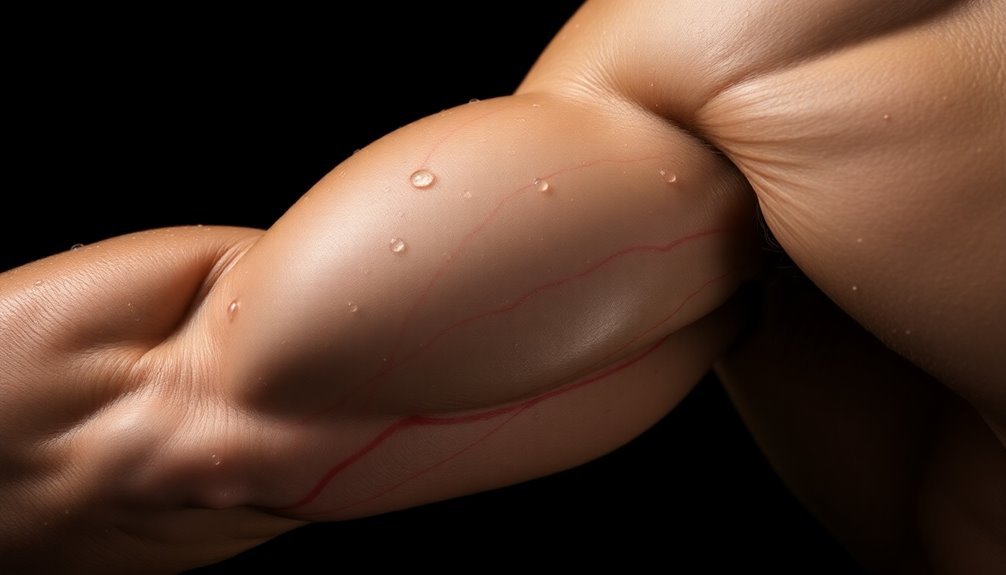
Your body's cellular repair mechanisms kick into high gear during recovery, with mitochondria – your cells' power plants – undergoing essential repairs to restore their energy-producing capacity.
Muscle protein synthesis accelerates as satellite cells activate and begin forming new muscle tissue, following a precise sequence of inflammation, regeneration, and remodeling. Each muscle fiber is surrounded by dense connective tissue that provides structural support during the repair process.
These regenerative processes are most effective when you provide adequate rest between training sessions, typically requiring 24-48 hours for most muscle groups to undergo substantial repair.
Mitochondrial Repair Process
Muscle recovery kicks into high gear when your mitochondria – the cellular powerhouses – begin their repair process. These tiny organelles play a vital role by producing the ATP needed for cellular repair and muscle regeneration.
During this phase, your muscle stem cells (MSCs) work in harmony with mitochondrial dynamics to restore damaged tissue and build new muscle fibers. The specific wavelengths of light between 600 to 1000 nanometers penetrate deep into muscle tissue to accelerate healing.
The repair process mirrors embryonic muscle development, following a highly synchronized pattern that involves necrosis, inflammation, and cellular reconstruction. Your mitochondria's enzyme activity, particularly citrate synthase, becomes essential for recovery as it helps maintain the energy supply needed for healing.
When you allow proper recovery time, you're enabling your mitochondria to optimize their function through processes like autophagy and biogenesis.
- Your mitochondria create protective adaptations through controlled peroxide production, helping shield muscle fibers during repair
- MSCs activate and proliferate while mitochondrial dynamics regulate their expansion and differentiation
- Red Light Therapy can enhance this process by boosting mitochondrial function and ATP production, speeding up your recovery
Understanding this repair cycle helps explain why adequate recovery time is essential for muscle growth and strength gains.
Muscle Protein Synthesis
Through cellular regeneration, protein synthesis forms the cornerstone of muscle recovery and growth. When you exercise, you create micro-tears in your muscle fibers, triggering a complex repair process that begins immediately after your workout.
Your body activates satellite cells, which serve as the primary drivers of muscle regeneration by proliferating and transforming into myoblasts. Research shows that single exercise sessions can stimulate muscle protein synthesis for up to 24 hours afterward.
To maximize this recovery process, you'll need to consume adequate protein within the critical post-exercise window. Aim for 0.2-0.5 grams of protein per kilogram of your body weight immediately after training. Your muscles remain sensitive to protein intake for up to 24 hours post-exercise, but early consumption optimizes the response.
You'll enhance these benefits by combining protein with carbohydrates in a 3:1 or 4:1 ratio, as this stimulates insulin secretion and supports recovery.
The complete regeneration of your muscle tissue typically takes 3-4 weeks, with initial myofiber formation occurring within 5-6 days. During this time, muscle-specific transcription factors regulate the activation and differentiation of satellite cells, ensuring proper repair and adaptation of your muscle tissue.
Deep Tissue Penetration Effects
In accordance with scientific research, deep tissue massage penetrates beyond superficial layers to trigger a cascade of healing responses in your body. When you apply consistent pressure for 10 minutes per muscle group, you'll enhance blood and lymph flow while stimulating mitochondrial biogenesis for cellular repair.
This mechanotherapy approach effectively clears inflammatory cells and promotes faster recovery from your workouts.
You'll notice substantial improvements in muscle recovery when you incorporate deep tissue work into your fitness routine. The pressure application helps reduce inflammatory cytokines and neutrophils, which is essential for proper muscle fiber regeneration. You're not just alleviating soreness – you're actively participating in your body's natural healing process.
- Accelerates recovery by increasing blood flow and clearing metabolic waste
- Reduces inflammation and promotes cellular repair through mechanical loading
- Improves flexibility and prevents future injuries by breaking down scar tissue
For ideal results, you'll want to customize your massage intensity based on your workout load and pain threshold. Whether you're dealing with DOMS or preparing for your next training session, maintaining a regular deep tissue routine can markedly enhance your overall athletic performance and recovery speed.
Muscle Recovery Enhancement Mechanisms
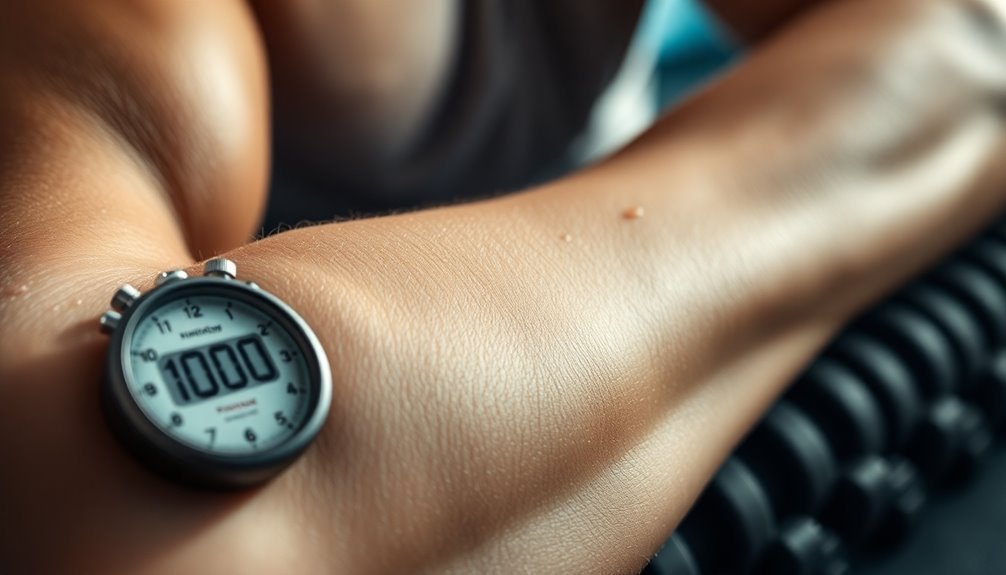
Building on the benefits of deep tissue work, your body employs multiple mechanisms to enhance muscle recovery after exercise. When you dedicate 10 minutes per muscle group, you'll activate key recovery processes that maximize healing and adaptation.
Your circulatory system kicks into high gear, removing lactate and hydrogen while delivering essential nutrients to damaged tissues.
During this recovery window, your muscles respond to both mechanical and biochemical signals. You'll trigger protein synthesis through proper nutrition, especially when you consume 20-40 grams of protein within two hours post-workout.
The compression and release actions stimulate blood flow while breaking down muscle knots through self-myofascial release. Your body's natural repair mechanisms work more efficiently when you combine active recovery techniques with proper rest periods.
You'll maximize these benefits by incorporating contrast therapy, whether through alternating hot and cold treatments or strategic compression. The 10-minute timeframe allows your muscles to fully engage with these recovery mechanisms, optimizing the balance between mechanical stress relief and metabolic rejuvenation.
This targeted approach guarantees you're giving each muscle group sufficient time to initiate and complete essential recovery processes.
Post-Workout Light Treatment Protocol
Effective light treatment protocols depend heavily on precise dosage and timing for ideal muscle recovery. You'll need to adjust the power output based on the muscle groups you're targeting – smaller muscles require 20-60 joules, while larger muscles need 60-300 joules for maximum results.
When treating post-workout, it's vital to maintain sessions for at least 15 minutes to achieve maximum benefits.
For the best recovery outcomes, timing your light therapy sessions is essential. If you're doing strength training, apply the treatment 5-10 minutes before your workout. For endurance or cardio sessions, you'll want to bookend your workout with treatment both before and after. Remember to focus on compound muscle groups and guarantee even coverage during application.
- Target specific muscle groups with appropriate power settings: lower output for small muscles, higher for larger ones
- Maintain consistent 15-minute sessions multiple times per week for maximum results
- Time your treatments strategically – before strength workouts, before and after endurance training
While individual needs may vary, following these protocols consistently will help maximize your recovery benefits. Adjust the power and duration based on your specific workout type and muscle groups for the most effective results.
Timing Your Light Therapy Sessions
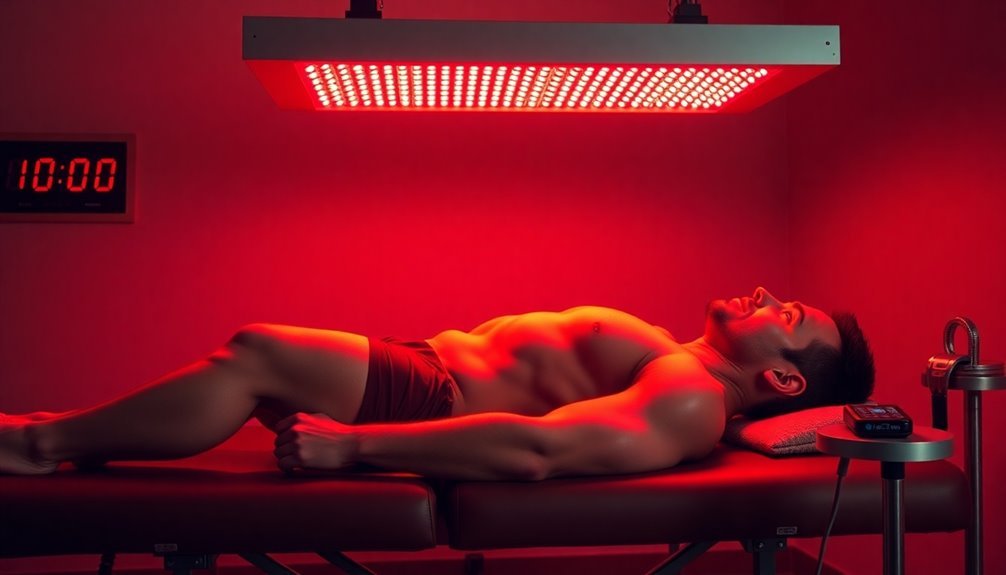
You'll get the most from your light therapy by targeting each muscle group for 5-10 minutes before workouts and 10-20 minutes after exercise, with at least 6 hours between sessions.
For ideal recovery, schedule your treatments during consistent time windows and focus on the specific muscles you've trained that day.
When treating multiple muscle zones, you can tailor the duration based on your needs, ranging from quick pre-workout exposure to longer post-exercise sessions that promote deep tissue recovery.
Optimal Daily Light Duration
Successful light therapy sessions depend heavily on proper timing and duration to achieve maximum recovery benefits.
For best results, you'll want to target each muscle group for 5-10 minutes during pre-workout sessions and 10-20 minutes post-workout. Position yourself 6-12 inches from the light source, ensuring proper exposure to both red light (630-700 nm) and near-infrared light (700-1200 nm) wavelengths.
Your recovery needs will dictate the frequency of sessions. For general recovery, aim for 3-4 sessions weekly, while intensive recovery may require daily treatments.
When dealing with larger muscle groups, you'll need 60-300 joules of output, compared to 20-60 joules for smaller muscles.
- Pre-workout sessions should last 5-10 minutes for strength training, with endurance activities requiring both pre and post-workout exposure.
- Injury rehabilitation demands longer sessions of 15-30 minutes, performed 3-4 times weekly.
- General wellness sessions should run 15-25 minutes for young adults and up to 30 minutes for older individuals.
Remember to adjust your session duration based on your age, physical condition, and recovery needs. Following manufacturer guidelines and maintaining consistency in your therapy routine will help optimize your results.
Peak Recovery Time Windows
Timing your light therapy sessions strategically can harness their full recovery potential. Research shows that applying red light therapy 3-6 hours before your workout delivers top performance benefits, with effects lasting up to 54 hours post-treatment. You'll experience enhanced endurance, strength, and reduced muscle soreness during your training session.
If you can't schedule a pre-workout session, don't worry. Post-exercise applications are equally valuable, accelerating muscle recovery and reducing inflammation through enhanced cellular repair and improved circulation. You'll notice faster recovery between training sessions and better muscle growth potential.
Your session duration should align with your specific needs. If you're younger, aim for 15-25 minutes per session, while older adults may benefit from 15-30 minutes. The intensity of your device and any existing health conditions will also influence your ideal treatment time.
For maximum effectiveness, make certain you're using the right wavelengths (810nm and 830nm) and keeping your dose under 60 Joules, as higher amounts can actually diminish benefits.
Whether you choose pre- or post-workout treatment, consistency in your application schedule is key to achieving peak recovery benefits.
Muscle-Specific Treatment Zones
Different muscle groups require specific light therapy approaches for best results.
When treating small muscles like biceps or calves, you'll want to stick to 5-10 minute sessions, while larger muscle groups like quads or back muscles need 10-20 minutes for ideal results.
You'll achieve the best outcomes by maintaining a 6-12 inch distance from the light source, regardless of muscle size.
For both pre and post-workout treatments, timing is essential. Apply light therapy 5-10 minutes before strength training to enhance performance, and wait 5-20 minutes after your workout for recovery benefits.
The wavelength combination of red light (630-700 nm) and near-infrared light (700-1200 nm) works effectively for all muscle groups.
- Small muscles require 20-60 joules of total power output, while larger muscles need 60-300 joules
- Maintain a consistent treatment frequency of 3-4 times per week for general recovery
- Monitor device temperature during sessions to prevent it from overheating
Remember to adjust your treatment duration based on muscle size and workout type – shorter sessions for small muscles and pre-workout preparation, longer sessions for larger muscles and post-workout recovery.
Recovery Zones and Light Application
Understanding recovery zones and applying light therapy effectively can transform your post-workout results.
When you're treating each muscle group, you'll need to guarantee both local and systemic recovery factors are addressed. Your muscles must recover enough to perform at least five quality reps on your next set, while your CNS and cardiorespiratory system shouldn't limit your performance.
You'll achieve the best results by applying red light therapy both pre and post-workout. Before training, it prepares your muscles and reduces injury risk. After training, it accelerates repair and reduces inflammation.
Position your device at the recommended distance and maintain consistent treatment times for each muscle group to maximize cellular repair and blood circulation benefits.
Your recovery speed will vary from others, so you'll need to assess your individual response. Most people can handle 2-4 back training sessions per week when recovery is enhanced.
Pay attention to your local muscle recovery, CNS fatigue, and synergist muscle readiness. When you're applying light therapy, target specific areas that need attention and maintain regular sessions to support your body's natural recovery processes.
Performance Benefits of Light Therapy
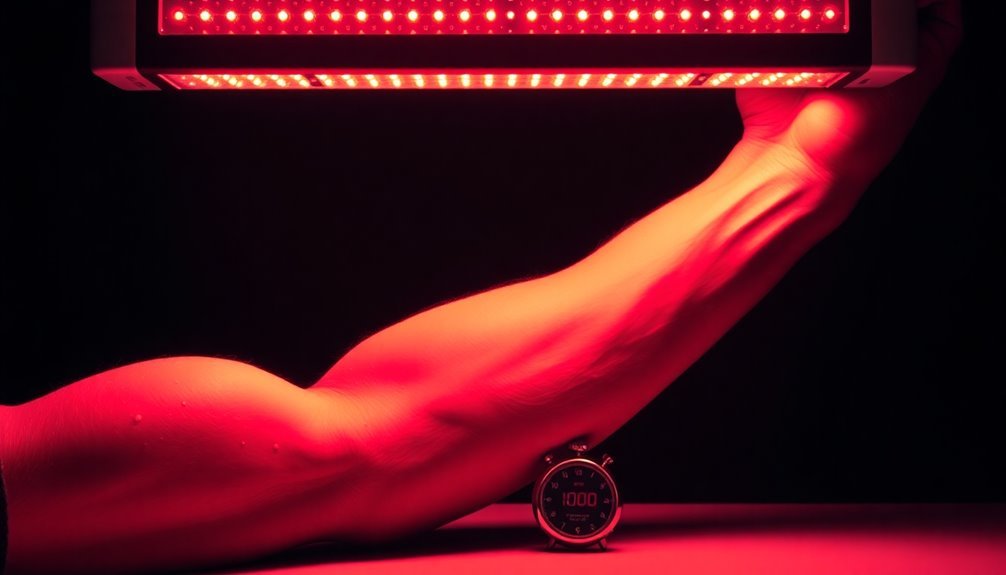
Light therapy offers a powerful array of performance advantages that extend well beyond basic recovery. You'll experience benefits before, during, and after your workouts, creating a thorough enhancement to your training routine.
When you use light therapy consistently, you're tapping into cellular-level improvements that boost ATP production, increase blood flow, and reduce inflammation throughout your body.
The therapy's impact on your performance timeline is remarkable, working at multiple stages of your fitness journey:
- Pre-workout: You'll notice enhanced muscle preparation and increased energy levels, setting you up for better performance from the start.
- During exercise: Your endurance improves as ATP production increases, while muscle fatigue decreases, allowing you to push harder.
- Post-workout: Recovery accelerates through faster muscle regeneration and reduced inflammation.
Beyond the immediate exercise benefits, you'll find improvements in your sleep quality and overall tissue health. The therapy's ability to reduce oxidative stress while promoting protein synthesis means you're not just recovering – you're actively building a stronger foundation for future performance.
This thorough approach makes light therapy an invaluable tool for anyone serious about optimizing their athletic potential.
Muscle Adaptation Through Light Exposure
The complex interplay between muscle adaptation and light exposure explores deeply into your body's cellular responses. When you expose your muscles to specific light wavelengths, you're activating intrinsically photosensitive retinal ganglion cells (ipRGCs) that mediate vital physiological functions affecting muscle recovery.
Your muscle's adaptation mechanisms respond distinctly to light through the regulation of the circadian timing system. Short-wavelength light particularly influences melanopsin sensitivity, which directly impacts your muscle's recovery response.
You'll find that this process isn't just about the light itself – it's about how your body's photoreceptors interact with ipRGCs to create ideal conditions for muscle adaptation.
The effectiveness of your recovery depends on how light exposure affects your neuroendocrine regulation and sleep patterns. Through specific wavelengths, you're able to influence your muscle's plasticity and gene expression.
Your skeletal muscles respond to these stimuli by adjusting their fiber composition and MHC isoforms, particularly MHC-IIA. When you're strategic about light exposure during your recovery periods, you're finely tuning your body's natural adaptation pathways to maximize muscle recovery benefits.
Light Treatment Safety Guidelines
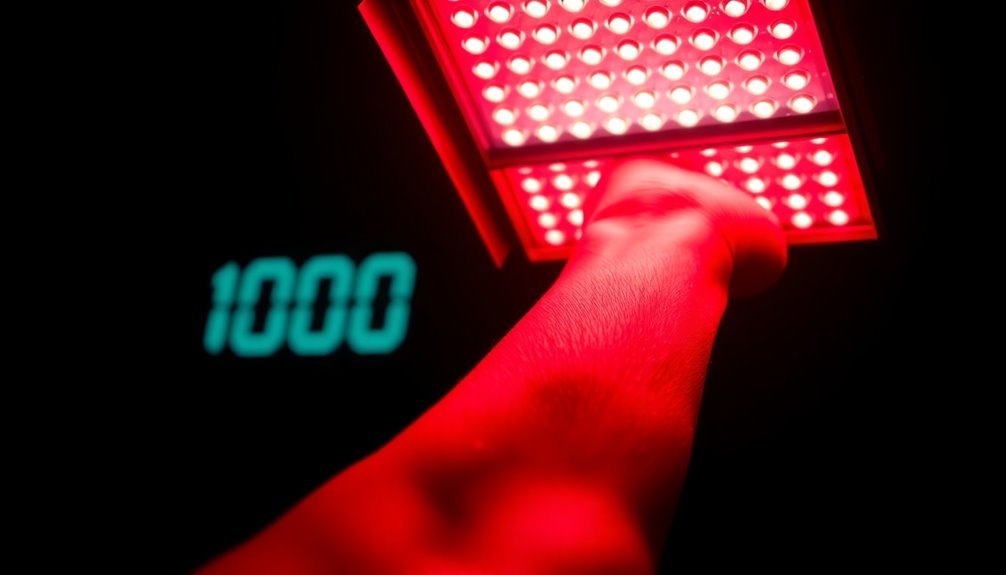
When implementing light therapy for muscle recovery, you must prioritize safety protocols to prevent potential complications and maximize treatment benefits. Always use FDA-approved devices and follow the manufacturer's instructions regarding power settings and treatment durations.
You'll need to wear appropriate protective eyewear specifically designed for laser therapy to shield your eyes from potential damage.
To guarantee safe and effective treatments, maintain proper airflow in your treatment area to prevent heat buildup. If you've recently had Botox or cosmetic fillers, wait at least seven days before starting light therapy sessions.
It's vital to document any adverse reactions you experience during or after treatment and immediately report them to a healthcare professional.
- Always use medical-grade eye protection designed specifically for your device's wavelength
- Monitor skin temperature during treatment to prevent burns or tissue damage
- Keep treatments to 10 minutes per muscle group to avoid overexposure
Remember that while light therapy is generally safe, improper use can lead to burns, skin irritation, or tissue damage. If you're new to light therapy, consider working with a trained professional who can guide you through proper technique and safety protocols.
Frequently Asked Questions
Can I Combine 10-Minute Muscle Sessions With Other Recovery Techniques?
You can definitely combine 10-minute muscle sessions with massage, compression garments, proper nutrition, and adequate sleep. These recovery techniques work together to enhance your results and help prevent muscle fatigue and soreness.
How Does Sleep Quality Affect the Effectiveness of 10-Minute Muscle Sessions?
Your 10-minute muscle sessions will be more effective when you're well-rested, as quality sleep enhances muscle repair and growth hormone release. Poor sleep can limit your recovery gains and reduce exercise benefits.
Should Beginners Start With Shorter or Longer Muscle Focus Periods?
You should start with shorter muscle focus periods as a beginner. This allows your body to adapt gradually, prevents overtraining, and helps you maintain proper form while minimizing the risk of injury.
Do Different Body Types Require Adjusted Timing for Muscle Recovery Sessions?
Yes, you'll need to adjust recovery timing based on your body type. Ectomorphs often need less recovery time, mesomorphs require moderate breaks, and endomorphs typically need longer recovery periods between muscle sessions.
What Supplements Best Support a 10-Minute per Muscle Recovery Routine?
You'll maximize your 10-minute muscle recovery with whey protein (20-25g), BCAAs (10-20g), creatine monohydrate, and citrulline malate (8-12g). Take tart cherry juice 5 days before and 3 days after training.
In Summary
You'll maximize your recovery benefits by sticking to the 10-minute sweet spot for each muscle group during red light therapy. Your cells' mitochondria won't gain additional advantages from longer exposure times. Remember to keep your sessions consistent, follow proper safety protocols, and avoid overexposure. By maintaining this timeframe, you're giving your muscles the ideal environment for regeneration and adaptation while ensuring the most efficient use of light therapy.





Leave a Reply